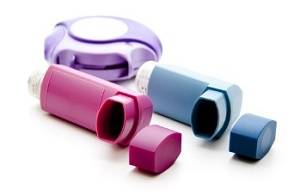ASTHMA INHALER COLOURS UK: Patients need to avoid confusion.
Inhaler users need to be sure they are taking the right medicine for the right purpose.
UKIG say the production of colour-coded asthma inhalers is increasing. It may actually put lives at risk because of the lack of an industry standard inhaler colour system.
Survey results showed the majority of respondents referred to inhalers by colour. Many healthcare professionals and patients call the short-acting b2-agonist inhalers the ‘blue inhaler‘.
The industry body responded. They said a standardised approach to inhaler colour coding would not be practical.
Primary Care Respiratory Medicine
Over 2,000 patients and healthcare professionals took part in the survey questions.
- 11.3% of those questioned said they never refer to the colour of their inhaler.
- 0.9% of 600 healthcare professionals questioned said they never referred to inhalers by colour.
- 86.8% of those said they described inhalers by their colour to patients ‘usually’ or ‘often’.
One report in Primary Care Respiratory Medicine showed inhaler colour coding is no longer consistent. They referred to several cases occurring within the last few years.
The UK licensed two inhalers which both had significant amounts of blue colouring. But, neither of these inhalers were actually produced for the emergency relief of symptoms.
Relvar Ellipta Inhaler Colour Change
 One was the Relvar Ellipta (fluticasone furoate/vilanterol) inhaler manufactured by GlaxoSmithKline. In fact they later changed the colouring from blue to yellow after patient lobbying.
One was the Relvar Ellipta (fluticasone furoate/vilanterol) inhaler manufactured by GlaxoSmithKline. In fact they later changed the colouring from blue to yellow after patient lobbying.
Professional organisations also instigated the colour change citing their concerns about its safety.
Pharmaceutical companies are increasing their own array of asthma inhaler colours. They do this to differentiate the treatments within their own product range.
The concern is their lack of conformity to any specific asthma inhaler colour code conventions.
Education for Health Warwick
The chief executive of UK charity Education for Health went on to say: “There is a range of inhalers and new treatments available. It is vitally important for patients, families, carers and school teachers to know which inhaler to use in an emergency.”
They want an industry-wide approach to asthma inhaler colour coding. That would help ensure a blue inhaler would not get a licence unless it is a reliever. Thus, inhalers which are not used to treat rapid symptom relief should not get licensed if they are blue.
One General Practitioner summed up the main concern by saying:
“What would happen in a real emergency when someone is struggling for breath? It is important that there is no room for confusion. It must be clear which inhaler will have a rapid effect to relieve the symptoms.”
Asthma UK also echoes the views and concerns of the researchers. They say the term ‘blue inhaler’ has been synonymous with the reliever inhaler for many years.
They expressed the importance of consistent and simple health messaging. There should be no confusion between people with asthma and their carers. Clear coherent instructions can save lives during a life-threatening asthma attack.
Medicines and Healthcare products Regulatory Agency
MHRA regulate medicines and medical devices in the United Kingdom. They are planning meet with UKIG members for discussions on their proposals.
The Association of the British Pharmaceutical Industry (ABPI) is a trade association of companies. They produce prescription medicines in the United Kingdom. They encourage all members to follow MHRA best practice on packaging and labelling.
But, they say a standardised approach would not be practical because:
“The manufacturing of inhalers includes many suppliers and partners across the world. They have different rules and regulations which are set by international regulators. So, expecting a single set of international standards would not be workable.”
Note: The short video explains why a pharmacist used the Yellow Card reporting scheme to highlight how a patient almost choked after placing a medicine into the wrong section of the inhaler.
ALSO IN THIS SECTION
Articles on Health and Safety: Get the latest stories about health regulations and safety rules.
Health and Wellbeing: Guidelines for taking charge of your own physical and mental health.
Norovirus Winter Bug: Follow these 7 tips to defeat the sickly winter vomiting virus.
Supplements for Dementia: Are the benefits substantiated or a myth?
Synthetic Alcohol: Could hangover free alcohol be the key to safer and improved mental health?
Weak Anti-pollution Laws: The UK has lax food poisoning and slipshod anti-pollution regulations.

